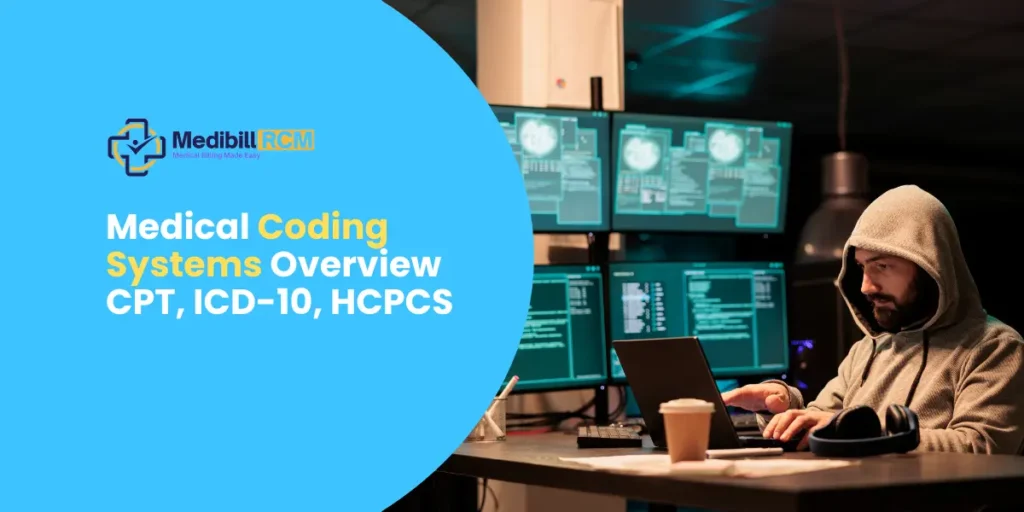Medical coding is a critical part of healthcare documentation and billing. Accurate coding ensures that healthcare providers are properly reimbursed for the services they provide. In the U.S., three primary coding systems are used: CPT (Current Procedural Terminology), ICD-10 (International Classification of Diseases, 10th Revision), and HCPCS (Healthcare Common Procedure Coding System).
This guide will explain the purpose of each coding system, how they differ, and why they are essential to the revenue cycle management process.
Medical Coding Systems CPT, ICD-10, HCPCS User Guide
1. Current Procedural Terminology (CPT)
What is CPT?
CPT codes are used to describe medical, surgical, and diagnostic procedures and services. The American Medical Association (AMA) developed the CPT system, which is widely used in the U.S. healthcare system for billing and documentation.
Structure of CPT Codes
CPT codes consist of 5 alphanumeric characters that describe specific medical procedures. There are three main categories of CPT codes:
- Category I: Most commonly used codes for services and procedures, ranging from 00100 to 99499.
- Category II: Optional codes used for performance management and data collection, typically for tracking patient outcomes.
- Category III: Temporary codes for emerging technology, services, and procedures that are not yet widespread.
Examples of CPT Codes
- 99213: Office or other outpatient visit for the evaluation and management of an established patient.
- 71020: Chest X-ray, 2 views, frontal and lateral.
How CPT Codes Are Used
CPT codes are used for:
- Medical Billing: Accurately describing procedures to insurance companies for reimbursement.
- Data Collection: Tracking healthcare trends and outcomes for quality improvement.
- Regulatory Compliance: Ensuring procedures follow national healthcare guidelines.
Updates to CPT
The AMA updates CPT codes annually to accommodate new technologies, procedures, and medical practices. Healthcare providers need to stay current with these updates to ensure accurate billing and avoid denials.
2. International Classification of Diseases, 10th Revision (ICD-10)
What is ICD-10?
The ICD-10 system, developed by the World Health Organization (WHO), is used to classify diseases, injuries, and other health conditions. It is the global standard for reporting medical diagnoses and is essential for identifying health trends and statistics.
Structure of ICD-10 Codes
ICD-10 codes are 3-7 alphanumeric characters long and are divided into two main parts:
- ICD-10-CM: Clinical Modification used for diagnostic coding in all healthcare settings.
- ICD-10-PCS: Procedural Coding System used in inpatient hospital settings for coding inpatient procedures.
Examples of ICD-10 Codes
- E11.9: Type 2 diabetes mellitus without complications.
- S72.001A: Fracture of the right femur, initial encounter.
How ICD-10 Codes Are Used
- Diagnostic Reporting: ICD-10 codes are used by healthcare providers to describe patient conditions or injuries.
- Medical Billing: They are required for medical claims processing to insurance companies and ensuring proper reimbursement.
- Public Health and Research: ICD-10 codes are used by public health organizations to track disease outbreaks and health trends.
ICD-10 Transition
The transition from ICD-9 to ICD-10 occurred in the U.S. in October 2015. ICD-10 offers greater specificity with over 68,000 diagnostic codes, compared to around 13,000 in ICD-9.
Key Differences Between ICD-9 and ICD-10
- ICD-10 is more specific: It provides detailed codes for even minor variations in diagnoses and conditions.
- Expansion of injury codes: ICD-10 includes better classification for external causes and factors.
3. Healthcare Common Procedure Coding System (HCPCS)
What is HCPCS?
The HCPCS is a set of healthcare procedure codes based on CPT codes, maintained by the Centers for Medicare and Medicaid Services (CMS). HCPCS is mainly used to identify products, services, and supplies not included in CPT coding.
Structure of HCPCS Codes
HCPCS codes consist of two levels:
- Level I: CPT codes, which are used for medical services and procedures.
- Level II: Codes that identify non-physician services such as ambulance services, durable medical equipment, prosthetics, and other supplies. HCPCS Level II codes consist of a single alphabetical letter followed by 4 digits.
Examples of HCPCS Codes
- A0428: Ambulance service, basic life support, non-emergency transport.
- E0118: Crutches, underarm, wood, adjustable or fixed, pair, with pads, tips, and hand grips.
How HCPCS Codes Are Used
- Medicare and Medicaid Billing: HCPCS codes are widely used for claims submitted to Medicare, Medicaid, and other insurance programs.
- Durable Medical Equipment (DME): HCPCS codes help identify specific medical devices and supplies, which CPT codes do not cover.
- Outpatient Billing: HCPCS is critical for billing outpatient services, especially for non-physician providers.
Updates to HCPCS
HCPCS codes are updated quarterly to reflect changes in medical technology and the needs of healthcare providers and patients.
Key Differences Between CPT, ICD-10, and HCPCS
| Feature | CPT | ICD-10 | HCPCS |
|---|---|---|---|
| Developed By | American Medical Association (AMA) | World Health Organization (WHO) | Centers for Medicare & Medicaid Services (CMS) |
| Usage | Describes medical procedures | Describes diseases and diagnoses | Identifies products, supplies, and non-physician services |
| Format | 5-digit numeric codes | 3-7 alphanumeric characters | Alphanumeric codes (Letter + 4 digits) |
| Primary Application | Medical billing, insurance claims | Diagnostic coding, research | Medicare/Medicaid billing, durable medical equipment |
Table 1: Key Difference Between CPT, ICD-10, and HCPCS Coding Systems
Why Accurate Medical Coding is Essential
Accurate medical coding is critical for:
- Proper Reimbursement: Incorrect codes can lead to claim denials or underpayments, negatively impacting the revenue cycle.
- Regulatory Compliance: Coding errors can result in audits or penalties.
- Patient Care: Proper coding helps track patient outcomes and ensures continuity of care.
Bottom Line
CPT, ICD-10, and HCPCS codes are the backbone of medical documentation, billing, and compliance in the U.S. healthcare system. Understanding these coding systems and staying up-to-date with changes is essential for healthcare providers and medical billing professionals to ensure accurate claims submission, avoid denials, and optimize revenue.
Related Posts
What is PC Ratio in Medical Billing? Definition, Calculation & Optimization


